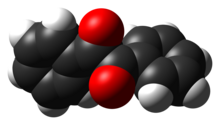
| |

| |

| |
| Names | |
|---|---|
| Preferred IUPAC name
Diphenylethanedione | |
| Systematic IUPAC name
1,2-Diphenylethane-1,2-dione | |
| Other names
Diphenylethane-1,2-dione
Benzil Dibenzoyl Bibenzoyl Diphenylglyoxal | |
| Identifiers | |
3D model (JSmol)
|
|
| 608047 | |
| ChEBI | |
| ChEMBL | |
| ChemSpider | |
| ECHA InfoCard | 100.004.689 |
| EC Number |
|
PubChem CID
|
|
| RTECS number |
|
| UNII | |
CompTox Dashboard (EPA)
|
|
| |
| |
| Properties | |
| C14H10O2 | |
| Molar mass | 210.232 g·mol−1 |
| Appearance | yellow crystalline powder |
| Density | 1.23 g/cm3, solid (1.255 g/cm3, x-ray) |
| Melting point | 94.0 to 96.0 °C; 201.2 to 204.8 °F; 367.1 to 369.2 K |
| Boiling point | 346.0 to 348.0 °C; 654.8 to 658.4 °F; 619.1 to 621.1 K |
| insoluble | |
| Solubility in ethanol | soluble |
| Solubility in diethyl ether | soluble |
| Solubility in benzene | soluble |
| -118.6·10−6 cm3/mol | |
| Structure | |
| P31,221[1] | |
| 3.8 D[2] | |
| Hazards | |
| Occupational safety and health (OHS/OSH): | |
Main hazards
|
Irritant |
| GHS labelling: | |

| |
| Warning | |
| H315, H319, H335 | |
| P261, P264, P271, P280, P302+P352, P304+P340, P305+P351+P338, P312, P321, P332+P313, P337+P313, P362, P403+P233, P405, P501 | |
| NFPA 704 (fire diamond) | |
| Lethal dose or concentration (LD, LC): | |
LD50 (median dose)
|
>3 g/kg (mouse, oral)[3] |
| Related compounds | |
Related diketones
|
diacetyl |
Related compounds
|
benzophenone glyoxal bibenzil |
Except where otherwise noted, data are given for materials in their standard state (at 25 °C [77 °F], 100 kPa).
| |
Benzil (i.e. Bz2, systematically known as 1,2-diphenylethane-1,2-dione) is the organic compound with the formula (C6H5CO)2, generally abbreviated (PhCO)2. This yellow solid is one of the most common diketones. Its main use is as a photoinitiator in polymer chemistry.[4]
